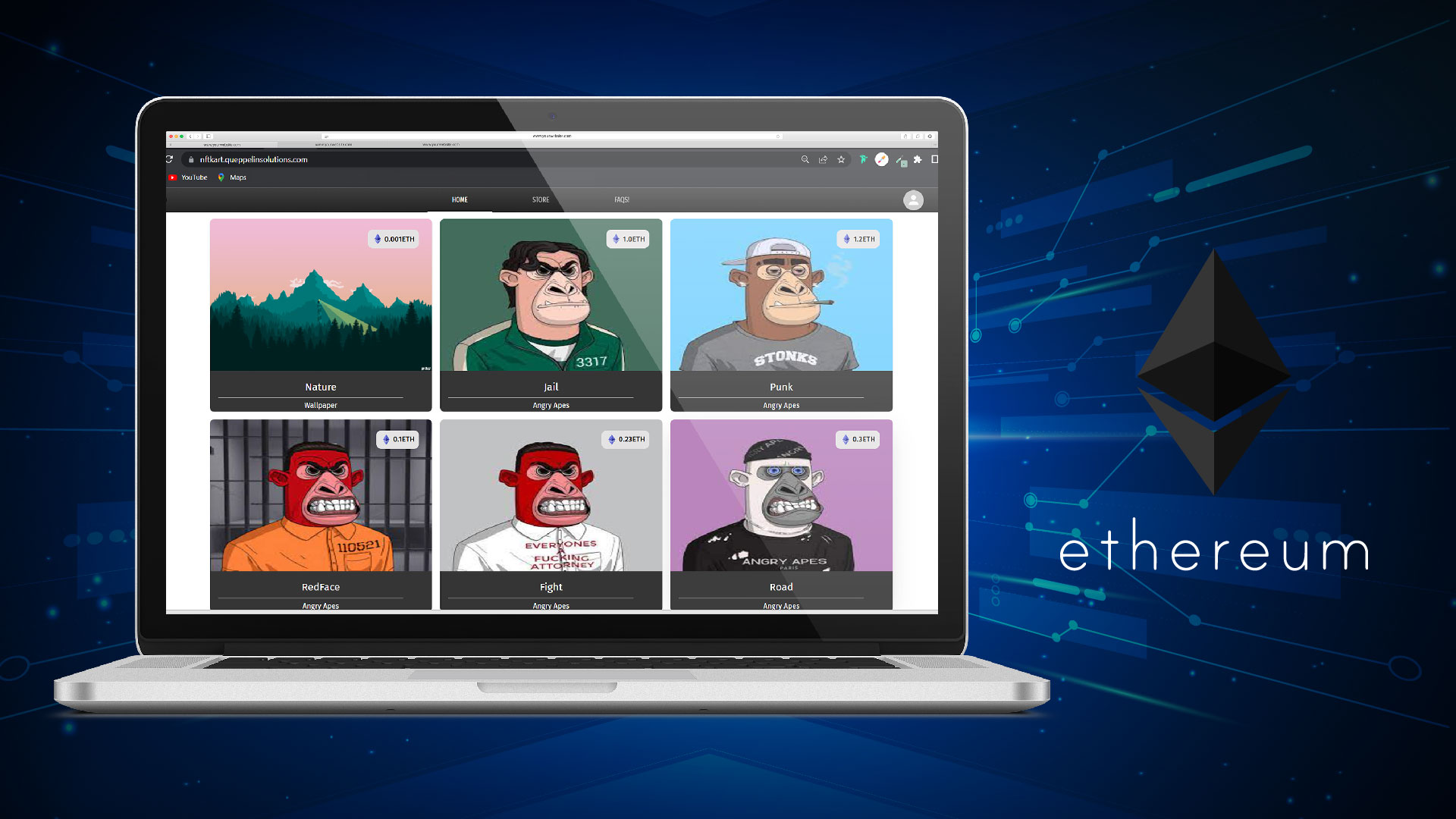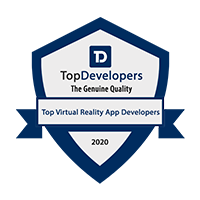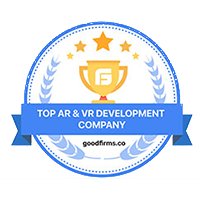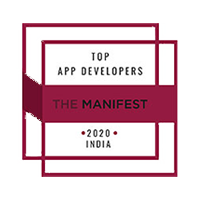The whopping prices that some NFTs have been able to rack up have taken the market by storm. The scores have crossed tens of millions of dollars and the total trading amount for some NFTs has even crossed the billion mark.
This led to the turning of heads and whether it is the individuals, celebrities, or organizations all are now keenly interested in this new opportunity. People are spending billions in this market segment without a second thought. This demand is surging even further as these tokens are finding more utility in the real world.
The best and the most preferred route to this adventure passes through the NFT marketplace where they can trade digital assets directly.
The reasons behind this popularity are simple yet crucial. They facilitate ease of gaining ownership & rights of NFTs and tracking and evaluating the digital asset’s record in-depth while trading.
Hence safety, security, performance, and transparency all can be achieved very easily with an NFT marketplace placed on a good blockchain network.
And currently, Ethereum is one of the most suitable platforms for the NFT marketplace. This is where NFT marketplace development services are helping investors make millions out of this booming digital asset market.
In this guide, we will comprehensively discuss the topic of the NFT marketplace, its features and functionality, Ethereum, and its benefits as the NFT marketplace platform. Most importantly, we will share how you can develop an NFT marketplace of your own and make the most out of this opportunity.
What is an NFT Marketplace?
You can understand the NFT marketplace as a virtual market where you can sell, buy, trade, or auction NFTs.
Non-fungible Tokens or NFTs are a kind of token that represent ownership of digital objects. These tokens are unique and irreplaceable and work on blockchain technology.
NFT marketplaces deal in various types of NFTs such as Multiverse NFTs, Sports, Gaming, Art and Music NFTs, and many others. It is a platform where creators from around the world can list their NFTs, mostly digital arts, and allow trade in them.
Moreover, auctioning of these digital assets on the NFT marketplace allows bidders from around the world to participate and acquire NFTs.
Such marketplaces work on blockchains which brings the much sought-after benefits such as security, transparency, and speed among others. Notably, blockchains are the primary source of digital currency creation.
In the NFT Marketplace, buyers can get their hands on these NFTs through their payment cards and cryptocurrencies.
Components & Architecture of an NFT marketplace
Here is a brief explanation of the vital components of an NFT marketplace and an illustration of its architecture.
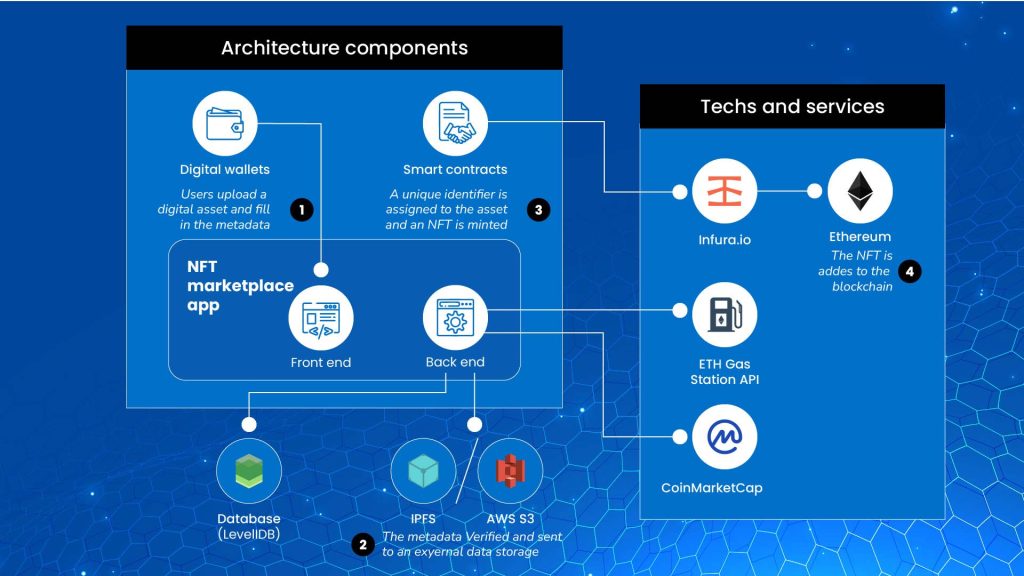
Structural Components of an NFT Marketplace
Marketplace App
A web application to facilitate the selling and buying of NFTs by the user. It has a client-side as well as a server-side.
Digital Wallet
An online service to store and use digital currency.
NFT metadata
It is the description of a digital asset sold as an NFT. It includes the name of the NFT, date of creation, owner, attributes, etc.
IPFS (Interplanetary File System)
A data storage system for blockchains. IPFSs help in power-saving in terms of digital assets storage.
Smart Contracts
They bring individuality to NFTs through a unique identifier. They employ the ERC-721 standard to create non-fungible tokens.
Blockchain
A distributed database that stores information regarding NFT transactions. These are decentralized ledgers that store immutable information.
Technology & Third-party service required
Ethereum
The most widely used blockchain for NFT marketplaces. It stores the NFT identifiers and links them to their digital assets.
ETH Gas Station
A facility to provide information on the cost of Ethereum transactions.
CoinMarketCap
A price-tracking service for the crypto market.
Infura.io
A service to access the Ethereum blockchain.
Golang
A programming language used for the back-end development of the NFT marketplace.
Solidity
A programming language for smart contracts.
LevelDB
A database for speedy blockchain access.
AWS S3
A cloud database with a range of storage categories for different data volumes.
Web3.js
An integral JavaScript library used for connecting with the Ethereum blockchain.
Truffle
To test and deploy the Ethereum smart contracts and custom dApps.
Ganache
Used along with local test nodes to verify the communication of smart contracts and their deployment.
Node.js
A software used for running backend or the js applications directly on Ethereum.
React.js
An open-source, free front-end language for developing UI components.
Metamask
A crypto wallet for transacting Ethereum tokens. It is also used to store keys for Ethereum cryptocurrency only.
What are the must-have features of an NFT marketplace?
NFT marketplace is a place where hundreds of people indulge in a range of trading activities. Hence it should offer a range of features for efficient trading. This will help artists and other content creators reach a global audience, they help NFT admirers explore a range of NFTs on a single platform, a win-win for all. Although the features of a marketplace vary with the blockchain, some must-have features should be present in a good marketplace.
Here is a list
Shop Window
Think of it like the dashboard of an NFT marketplace. It is to present information and description of the inventory of the digital assets including name, price, description, owner, payment method, and more.
Registration Process
The marketplace should facilitate the entry of new users through new account registration. Here, they could create a new wallet or integrate existing crypto wallets and complete all other processes required to trade-in NFTs.
Filters
The filter function is to ease the search by a user by narrowing it down in terms of the price range, digital asset type, and listing procedure.
NFT Minting
Marketplaces should motivate users to mint their own NFT. The marketplace should allow users to link their NFTs to the Blockchain.
Create Listings
This feature is to enable customers to create and list their assets instantly and hassle-free. The marketplace should allow users to upload files along with the product specification including title, tags, and description.
Auction page
NFT marketplace tends to incentivize the bidding process through a dedicated auction page. The users can bag additional benefits for initiating the bidding process.
Alerts
Notifications and alerts to the users are important to keep them updated. For example, when a new NFT is listed under a user-defined category then the user should get the notification instantly.
Crypto wallet
The NFT marketplace has an in-built digital wallet. It can be used to store and transfer cryptocurrencies by the user.
Customer Support
It is certainly a must-have feature for a great, well-functioning, and successful NFT marketplace. This will not only help customers in solving their queries but also the marketplace will receive crucial feedback and input to enhance their services.
User History
The NFT marketplace should record, store and display users’ history. It should include user trading data, NFTs listed, approved, bought, and sold. It’s better to consult with an expert NFT marketplace services provider to avoid any form of discrepancy or malfunctioning of the marketplace before you jump right into the business.
How does the NFT Marketplace work?
To understand the functioning of an NFT marketplace, we have to break it into two parts – Process at the front end and that at the back end.
Front-end: from the perspective of a new user
The user can choose to be both the seller and the buyer. We will understand the process from a new seller’s perspective as it covers the whole topic.
It starts with the creation of a new account. A crypto wallet is linked to it. Now, if the user wants to be a buyer then they can start buying right away and their crypto wallet will keep on updating accordingly.
In this case, the user chooses to be a seller. Then first, they have to create an NFT and configure it on the marketplace. The NFT gets displayed on the marketplace after the listing is moderated.
The interested buyer bid for the NFT and the higher bid wins the auction. The NFT is sold and the crypto-wallet is updated at the end of the transaction.
Backend
The marketplace creates a blockchain-based contract for every NFT listed on its platform. The tokens are added to a unique data form called metadata. Here, the unique identifiers are added to the NFT to make it distinct and identifiable.
Smart contracts are used by every NFT marketplace to regulate, monitor, and approve transactions.
These smart contracts have the unique identifier of all the NFTs and make sure that there is only one owner of that NFT around the world.
What is Ethereum?
Ethereum is an open-source Blockchain platform that allows developers to create, store, and implement smart contracts and decentralized applications (dApps).
Smart Contracts are automated contracts stored as a computer protocol that gets auto-executed once pre-specified conditions meet. Know more about Smart Contracts.
Decentralized Applications or dApps are just like web applications where all stakeholders including users have the decision-making power instead of a centralized authority.
Ethereum is popularly known for digital transactions as it permits transactions in cryptocurrency for a small fee. However, it can be used for various other digital assets as well. The blockchain network is known for its robustness to prevent any third-party interference, ownership manipulation, downtime, and other risk factors on its blockchain.
Why is Ethereum the most suitable Blockchain for the NFT Marketplace?
Ethereum brings a lot of the advantages that make it a robust and highly potent platform for NFT marketplaces. That is why Ethereum has been home to some of the most popular NFT marketplaces like Opensea, Rarible, and Larva Lab. Learn how you develop NFT marketplace like Opensea and others.
Private Transactions
Ethereum allows the creation of private consortia having secured transaction layers. The private information in such consortia is encrypted and is never broadcasted to participants in the network on ConsenSys Quorum. This facilitates better management of the NFT marketplace.
Performance
Consortium networks perform much better than the public mainnet. It can notch up a speed of 100 TPS depending upon the network design. Consortia allow Proof of Authority consensus, configurable block time, and gas limits to operate better.
Data Coordination
The decentralized design distributes data to build trust. It eliminates the user’s reliance on a centralized authority to operate the system and execute transactions. Hence, the marketplace on Ethereum can function more efficiently and rapidly.
Rapid Deployment
It allows faster deployment of the dapps which means as soon as the dapp is uploaded on the platform it gets available to all the nodes on the network. Thus, they can install and administer the transaction right away on Ethereum such as exchange, mining, and storage. Thus, the marketplace will go global in no time.
Permissioned networks
Firms can build their set up on a public Ethereum network through the open-source protocol layer ConsenSys Quorum. This will help them meet future regulatory and security requirements. This is an important advantage for the marketplace. Not only they can operate with transparency but also avoid unnecessary regulatory hurdles.
Scalability
Unlike other blockchain networks that run on a limited number of nodes with no scope for future expansions, the Ethereum mainnet is a clear example of a network functioning with multiple nodes having millions of users. For growing NFT marketplace endeavors, Ethereum is the way to go for scalability.
How to develop an NFT marketplace on Ethereum?
Following is a step-by-step guide to developing an NFT marketplace like OpenSea on the Ethereum platform.
- Repository creation
It starts with repository creation i.e. you have to fork or clone the repository in your Github account.
“$ git clone https://github.com/miquelTC/nft-marketplace.git:”- Dependencies installation
Then, you have to follow the below-given command to install the dependencies.
“$ npm install”- Truffle Installation
Post-installation of dependencies, you need to install Truffle globally via the following command in the terminal.
“$ npm install -g truffle”- Smart Contract Testing
First, compile the smart contracts and run them on your terminal. Use the following command.
“$ truffle compile”- Ganache Installation and Running
Install Ganache and run to operate your blockchain locally (https://www.trufflesuite.com/ganache)
Then, execute the tests validating your solutions through the following command.
“$ truffle test”- Deployment
Now is the time for contract deployment on your local blockchain by the following command,
“$ truffle migrate”- User Interface Opening
For this, you need to install a Metamask wallet as a browser extension, https://metamask.io/
Then, configure your Metamask by following these steps,
- Click on Metamask
- Select Network Configuration Panel
- Click on custom RPC
- Keep configuring your network by adding http://localhost:7545 on the URL and 1337 in the chain ID.
- Copy-paste the Private Account Key from Ganache into Metamask to integrate the first Ganache account with Metamask.
- Finally, type the following command to access the User Interface.
“$ npm start”- Deployment
Now is the time to execute the Smart Contract. For this, generate an an.env file and specify the following:
PRIVATE KEYS – The private key of the account for the deployment
INFURA API KEY – The API key by Infura
Execute the following command after that.
“$ truffle migrate –network ropsten”
Lastly, use the following command to produce UI’s build artifact and deploy them to the host,
“npm run build”What is the cost of NFT Marketplace Development on Ethereum?
The cost of building an NFT marketplace is one of the most crucial aspects from a business standpoint.
As with most cases, the final cost for an NFT marketplace development and deployment varies along with various factors such as the project scale, features included, technology stack, and charges by the NFT development company, among others.
However, to give you a general idea, the cost hovers between $10,000 to $50,000 with basic features only. It will soar higher with advanced features.
